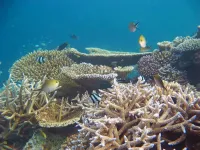(Press-News.org) Predicting the potential effects of coral loss on fish communities globally is a fundamental task, especially considering that reef fishes provide protein to millions of people. A new study led by the University of Helsinki predicts how fish diversity will respond to declines in coral diversity and shows that future coral loss might cause a more than 40% reduction in reef fish diversity globally.
Corals increasingly bleach and often die when the water warms. What happens to fish if there are no alternative reefs to swim to? The few fish species that feed on corals will inevitably starve, but the rest might find alternative rocky habitat to persist. As yet, it has been hard to do the larger-scale studies that can project what fish will remain in a world without corals. A new study led by Giovanni Strona at the University of Helsinki finds that global projections of fish diversity without corals are as low as small-scale experiments suggest.
An international team of marine biologist started by mapping tropical fish and coral diversity across the world's oceans for every square degree latitude and longitude. These unprecedented maps showed what marine biologists have long known, fish and coral diversity vary widely, with many more species in the Indo-Pacific "coral triangle" than in the western Atlantic and eastern Pacific. Marine diversity hotspots have been long explained by the way that latitude, habitat, temperature, and geography affect speciation and extinction rates among corals and fishes alike. After controlling for factors that drive diversity in general, the authors found that areas with diverse corals still tended to have more diverse fishes, suggesting that coral diversity begets fish diversity.
"This is not particularly surprising given that corals provide a unique food source for some species, as well a three-dimensional habitat that many species use for shelter. And the fish that depend on corals may be prey for fish that don't depend directly on corals," says the lead author Giovanni Strona from the University of Helsinki.
After fitting the line between coral diversity and fish diversity, the authors did a simple thought experiment. They anticipated global coral extirpation by extrapolating the fish vs corals association down to the point where no coral species were left. That extrapolation suggested that around 40% of the world's tropical reef fishes are likely to disappear should corals disappear. As shown in smaller scale experiments, this is a much bigger loss than those species known to depend directly or even indirectly on coral, suggesting that coral reef food webs will begin to unravel if corals do go extinct. This unravelling is expected to be more intense some places than others. The Central Pacific is expected to lose more than 60% of its reef fish, compared with only 10% in the Western Atlantic.
"We first devised a statistical model to disentangle the effect of environment, biogeography and history on fish and coral diversity that accurately predicting local-scale fish diversity as a response to several environmental variables such as water temperature, pH and salinity and coral diversity," Strona explains.
"Besides offering a way to predict fish diversity under novel environmental conditions, the approach offered a tool to explore how fish diversity will vary in response to changes in coral diversity", continues Valeriano Parravicini, a co-leader of the study at the University of Perpignan.
"For anyone who has enjoyed snorkeling on a coral reef, or for the millions of people that depend on reef fishes for food, this thought experiment should be concerning. But it also inspires greater efforts to conserve and restore coral reefs. The benefits of doing so would extend far beyond corals, to fish and other organisms that depend directly or indirectly on corals," says Kevin Lafferty, Senior Scientist with the U.S. Geological Survey, at the University of California, Santa Barbara.
INFORMATION:
By the beginning of April 2021, the number of people infected during the COVID-19 pandemic had risen to more than 130 million people of whom more than 2.8 million died. The SARS-CoV-2 virus responsible for COVID-19 is transmitted particularly by droplets or aerosols emitted when an infected person speaks, sneezes or coughs. This is how the viruses and other pathogens spread through the environment and transmit infectious diseases when they are inhaled by someone else.
The capacity of these particles to remain suspended in the air and to spread in the environment depends largely on the size and nature of the air flow generated by the expiration of air. As with other airborne infectious diseases such as tuberculosis, common flu ...
Significantly higher rates of child intensive care admissions for unintentional cannabis poisonings have been seen following legalization of the drug in Canada.
Researchers from The Hospital for Sick Children (SickKids), based in Toronto, found a four-fold increase in unintentional poisonings in children under the age of 12 and a three-fold increase in intensive care admissions for severe cannabis poisoning in the first two years following cannabis legalization.
However, the overall number of visits per month for cannabis intoxications to the SickKids Emergency Department (ED) remained consistent when comparing the pre- and post-legalization ...
Researchers at the National Institute of Standards and Technology (NIST) have upgraded their laser frequency-comb instrument to simultaneously measure three airborne greenhouse gases -- nitrous oxide, carbon dioxide and water vapor -- plus the major air pollutants ozone and carbon monoxide.
Combined with an earlier version of the system that measures methane, NIST's dual comb technology can now sense all four primary greenhouse gases, which could help in understanding and monitoring emissions of these heat-trapping gases implicated in climate change. The newest comb system can also help assess urban air quality.
These NIST instruments identify gas signatures by precisely measuring the amounts of light ...
A McGill-led study has shown that the size of the Maya population in the lowland city of Itzan (in present-day Guatemala) varied over time in response to climate change. The findings, published recently in Quaternary Science Reviews, show that both droughts and very wet periods led to important population declines.
These results are based on using a relatively new technique involving looking at stanols (organic molecules found in human and animal faecal matter) taken from the bottom of a nearby lake. Measurements of stanols were used to estimate changes in population size and to examine how they align with information about climate variability and changes in vegetation drawn from other biological and archaeological sources.
By using the technique, the researchers were able ...
Increasing our understanding of cellular processes requires information about the types of biomolecules involved, their locations, and their interactions. This requires the molecules to be labeled without affecting physiological processes (bioorthogonality). This works when the markers are very quickly and selectively coupled using small molecules and "click chemistry". In the journal Angewandte Chemie, a team of researchers has now introduced a novel type of click reaction that is also suitable for living cells and organisms.
As an example, labeling biomolecules allows for the localization and characterization of tumors ...
A new Finnish study shows that 180 health care workers who had received two doses of the Pfizer and Biontech vaccine have very good antibody responses against the SARS-CoV-2 virus. The immune response was as strong against the alpha variant (formerly the UK variant) but was somewhat decreased against the beta variant (formerly the South Africa variant).
Finnish researchers from the University of Turku and University of Helsinki together with Turku University Hospital, Helsinki University Hospital, and the Finnish Institute for Health and Welfare studied the immune response induced by the coronavirus vaccinations, which started in Finland in December. The researchers analysed vaccine responses ...
Growing in popularity, unagi kabayaki - grilled freshwater eel in soy sauce - can be found on the menu of many Japanese restaurants, and is stocked by Asian shops and in specialist supermarkets. But new research tracing the DNA of eel fillets used for this dish has found that fraudulent food labelling is rife, with a third of the products violating EU regulations on the provision of food information. With certain species of eels now endangered, the researchers say that accurate labelling on these products is vital if the global eel trade is to be sustainable.
The European eel is a critically ...
Plants play an essential role in curbing climate change, absorbing about one-third of the carbon dioxide emitted from human activities and storing it in soil so it doesn't become a heat-trapping gas. Extreme weather affects this ecosystem service, but when it comes to understanding carbon uptake, floods are studied far less than droughts - and they may be just as important, according to new research.
In a global analysis of vegetation over more than three decades, Stanford University researchers found that photosynthesis - the process by which plants take up carbon dioxide from the atmosphere - was primarily influenced by floods and heavy rainfall nearly as often as droughts in many locations. The paper, published in Environmental Research Letters on June ...
A key component of next-generation solar panels can be created without expensive, high-temperature fabrication methods, demonstrating a pathway to large scale, low-cost manufacturing for commercial applications.
Nickel oxide (NiO) is used as an inexpensive hole-transport layer in perovskite solar cells because of its favourable optical properties and long-term stability.
Making high-quality NiO films for solar cells usually requires an energy intensive and high-temperature treatment process called thermal annealing, which is not only costly, but also incompatible with plastic substrates, until now precluding the use of ...
Spatial reasoning ability in small children reflects how well they will perform in mathematics later. Researchers from the University of Basel recently came to this conclusion, making the case for better cultivation of spatial reasoning.
Good math skills open career doors in the natural sciences as well as technical and engineering fields. However, a nationwide study on basic skills conducted in Switzerland in 2019 found that schoolchildren achieved only modest results in mathematics. But it seems possible to begin promoting math skills from a young ...



